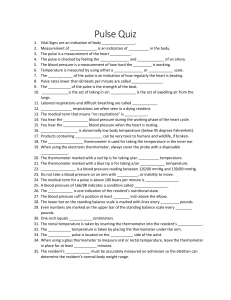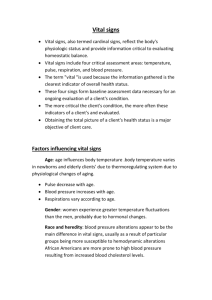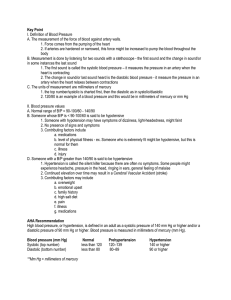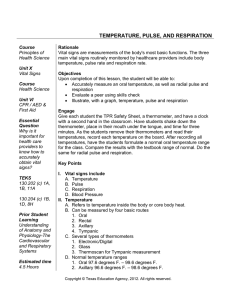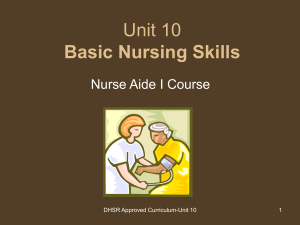Vital Signs
advertisement
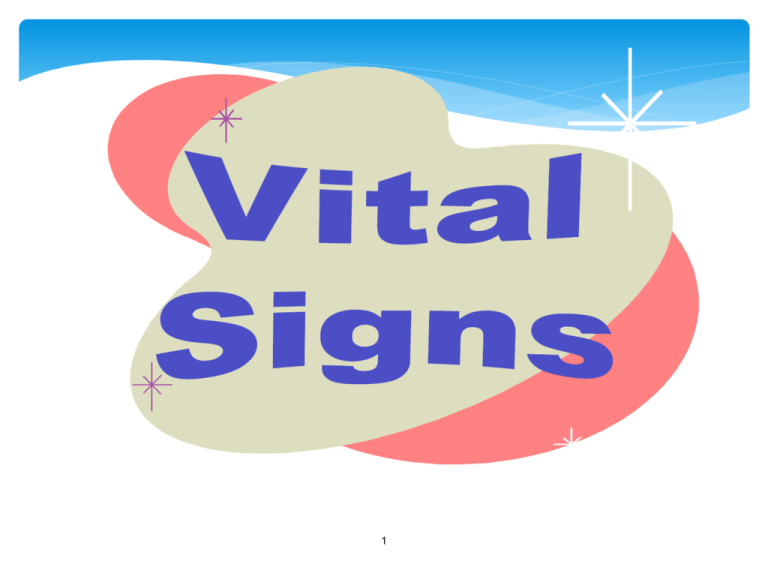
1 Provide basic Physiological skills. 2 Vital Signs Reflect the function of three body processes that are essential for life. Regulation of body temperature Heart function Breathing 3 Explain the meaning of vital signs and the abbreviations used for each vital sign. 4 Vital Signs (continued) Abbreviations: Temperature – T Pulse – P Respirations – R Blood Pressure – BP Vital signs - TPR and BP 5 Vital Signs (continued) Purpose Measured to detect any changes in normal body function Used to determine response to treatment 6 Vital Signs (continued) Measurement (taken at rest) Temperature - measures body heat Pulse - measures heart rate Respiration - measures how often resident inhales and exhales Blood Pressure - measures pressure against walls of arteries 7 8 Define body temperature and discuss the way it is measured. 9 Temperature – Measurement Of Body Heat Heat production muscles glands oxidation of food Heat loss respiration perspiration excretion 10 Temperature – Measurement Of Body Heat (continued) Balance between heat production and heat loss is body temperature 11 Factors Affecting Temperature Exercise Illness Age Time of day Medications Infection Emotions Hydration Clothing Environmental temperature/air movement 12 Equipment - Thermometer Instrument used to measure body temperature Types Non-mercury glass oral rectal 13 Equipment - Thermometer Types (continued) chemically treated paper – disposable plastic – disposable electronic - probe covered with disposable shield tympanic - electronic probe used in the ear 14 Normal Temperature Range For Adults Oral - 97.6 - 99.6 F (Fahrenheit) or 36.5 37.5 C (Celsius) Rectal - 98.6 - 100.6 F or 37.0 - 38.1 C Axillary - 96.6 - 98.6 F or 36.0 - 37.0 C 15 Read a non-mercury glass thermometer. 16 To Read A Non-mercury Glass Thermometer Hold eye level Locate solid column of liquid in the glass Observe lines on scale at upper side of column of liquid in the glass 17 To Read A Non-mercury Glass Thermometer (continued) Read at point where liquid ends If liquid falls between two lines, read it to closest line long line represents degree short line represents 0.2 of a degree Fahrenheit 18 List and discuss the sites used to take a temperature. 19 Sites To Take A Temperature Oral – most common Rectal – registers one degree Fahrenheit higher than oral Axillary – least accurate; registers one degree Fahrenheit lower than oral Tympanic – probe inserted into the ear canal 20 Sites To Take A Temperature (continued) Condition of resident determines which is the best site for measuring body temperature 21 Review safety precautions that should be considered when using a thermometer. 22 Temperature: Safety Precautions Hold rectal and axillary thermometers in place Stay with resident when taking temperature Check glass thermometers for chips Prior to use, shake liquid in glass down Shake thermometer away from resident and hard objects 23 Temperature: Safety Precautions (continued) Wipe from end to tip of thermometer prior to reading Delay taking oral temperature for 10 - 15 minutes if resident has been smoking, eating or drinking hot/cold liquids. 24 Demonstrate the procedure for measuring an oral temperature using a nonmercury glass thermometer. 25 26 Define pulse and discuss the way it is measured. 27 Measurement of Pulse Pulse is pressure of blood pushing against wall of artery as heart beats and rests Pulse easier to locate in arteries close to skin that can be pressed against bone 28 Sites For Taking Pulse Radial – base of thumb Temporal – side of forehead Carotid – side of neck Brachial – inner aspect of elbow Femoral – inner aspect of upper thigh 29 Sites For Taking Pulse (continued) Popliteal - behind knee Dorsalis pedis – top of foot Apical pulse – over apex of heart taken with stethoscope left side of chest 30 List the factors that affect the pulse. Age Sex Position Drugs Illness Emotions Activity level Temperature Physical training 31 Measurement of Pulse Normal pulse range/characteristics: 60 100 beats per minute and regular Documenting pulse rate Noted as number of beats per minute Rhythm - regular or irregular Volume - strong, weak, thready, bounding 32 33 Define respiration and discuss how the respiratory rate is measured. 34 Measuring Respirations Respiration – process of taking in oxygen and expelling carbon dioxide from lungs and respiratory tract 35 Factors Affecting Rate Age Activity level Position Drugs • Sex • Illness • Emotions • Temperature 36 Identify the qualities of normal respirations. Qualities of normal respirations 12-20 respirations per minute Quiet Effortless Regular 37 Measuring Respirations (continued) Documenting respiratory rate Noted as number of inhalations and exhalations per minute (one inhalation and one exhalation equals one respiration) Rhythm – regular or irregular Character: shallow, deep, labored 38 39 Define blood pressure and discuss how it is measured. 40 Measuring Blood Pressure Blood pressure is the force of blood pushing against walls of arteries Systolic pressure: greatest force exerted when heart contracting Diastolic pressure: least force exerted as heart relaxes 41 Factors Influencing Blood Pressure Weight Sleep Age Emotions Sex Heredity Viscosity of blood Illness/Disease 42 Blood Pressure: Equipment Sphygmomanometer (manual) cuff - different sizes pressure control bulb pressure gauge – marked with numbers aneroid mercury 43 Blood Pressure: Equipment (continued) Stethoscope magnifies sound has diaphragm 44 Identify the normal blood pressure range. 45 Measuring Blood Pressure Normal blood pressure range Systolic: 90-140 millimeters of mercury Diastolic: 60-90 millimeters of mercury 46 Guidelines for Blood Pressure Measurements Measure on upper arm Have correct size cuff Identify brachial artery for correct placement of stethoscope 47 Guidelines for Blood Pressure Measurements (continued) First sound heard – systolic pressure Last sound heard or change - diastolic pressure 48 Guidelines for Blood Pressure Measurements (continued) Record - systolic/diastolic Resident in relaxed position, sitting or lying down Blood pressure usually taken in left arm 49 Guidelines for Blood Pressure Measurements (continued) Do not measure blood pressure in arm with IV, AV shunt (dialysis), cast, wound, or sore 50 Guidelines for Blood Pressure Measurements (continued) Apply cuff to bare upper arm, not over clothing Room quiet so blood pressure can be heard Sphygmomanometer must be clearly visible 51 Blood Pressure: Reading Gauge Large lines are at increments of 10 mmHg Shorter lines at 2 mm intervals Take reading at closest line 52 Blood Pressure: Reading Gauge (continued) Gauge should be at eye level Mercury column gauge must not be tilted Reading taken from top of column of mercury 53 300 290 280 270 260 250 240 230 220 210 200 190 180 170 160 150 140 130 120 110 100 90 80 70 60 50 40 30 20 10 54 Discuss height and weight and how it is measured. 55 Measuring Height And Weight Baseline measurement obtained on admission and must be accurate. Other measurements obtained as ordered. 56 Measuring Height And Weight (continued) Height measurements Feet Inches Centimeters Weight measurements Pounds Ounces Kilograms 57 Measuring Height and Weight (continued) Reasons for obtaining height and weight Indicator of nutritional status Indicator of change in medical condition Used by doctor to order medications 58 List three guidelines for weighing residents. 59 Measuring Height and Weight (continued) Guidelines for weighing residents Use same scale each time Have resident void, remove shoes and outer clothing Weigh at same time each day 60 Measuring Height and Weight (continued) Scales Remain more accurate if moved as little as possible. Various types of scales bathroom scale standing scale scales attached to hydraulic lifts wheelchair scales bed scales 61 62
